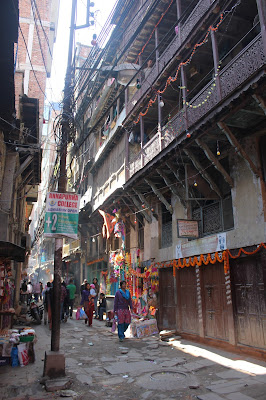Bhaktapur, Nepal: I took a day trip to a small city near Kathmandu. Bhaktapur is an ancient Newar town and listed as a World Heritage by UNESCO for its rich culture, temples, and wood, metal and stone artwork. It is an untouched and preserved ancient city that is well worth exploring. Heck, I would recommend skipping Kathmandu when you arrive and go stay in Bhaktapur.
Portions of the movie Little Buddha (1993) starring Keanu Reeves were filmed in the Bhaktapur. The story goes that the movie people suggested to the locals that in order to perserve Bhaktapur they charge tourists admission to the city. It cost US$13 to enter the city and supposedly the money goes to maintaining sites, infastructure, etc. Some locals dispute the idea that the money finds its way to these causes but Bhaktapur was in far better shape than any other town I had been in so they must be doing something right.
 |
Temple of Nyatapola.
This is one of the tallest pagoda-style temples in Kathmandu Valley and is famous for its massive structure and subtle workmanship.
|
 |
Up close photo of carving found on one of the temples.
Wood carving is intricate, plentiful and beautiful. |
 |
| Hindu worshippers. |
 |
Friends greeting each other in the street.
The male inhabitants of this city wear a special type of cap called the Dhaka Topi.
|
 |
Itinerant basket seller (left).
He carries his wares on his head, hence the turban type headgear worn for cushioning. |
 |
| Bhaktapur sees a lot of tourists. I stepped away from the well trodden areas of the city and started to explore some side streets and areas. The raised road way was made of stone with gutters on each side. Probably good to have during the monsoon time. |
 |
| I came upon a square where the women were drying rice in the sun. |
 |
| Continuing on, there was more rice drying and being raked and cleaned. |
 |
| Taking a rest and surveying their domain. |
 |
Of course I am always on the look out for cats.
Here's a lovely brass statue. |
 |
| ME-OW-ZIG was a music store selling a lot of local music both secular and sacred. The owner had music blasting from his shop and that's what drew me to the location. The cat was an added bonus. |
 |
| Drying hay and making terracotta pots. Both full time activities in Bhaktapur. |
 |
| Bhaktapur is a famous centre for wood carving and in this workshop I found two women carvers. Good for them! |
 |
| Typical shop front. |
 |
The famous "Peacock Window" wood carving. The window adorns the Pujari Math (Hindu monastery) which, with rows of exquisitely carved windows and doors, is equally appealing. It is sometimes referred to as the "Mona Lisa of Nepal" and a rare masterpiece in wood. Dating back to the early 15th century it is an excellent example of wooden fretwork that you see all over the Kathmandu valley.
|
 |
Literally next door to the "Peacock Window" is the "Chicken Window"!
Coincidence? I think not. |


















































